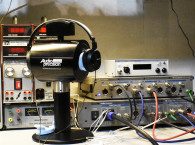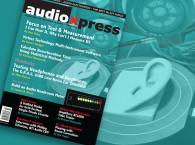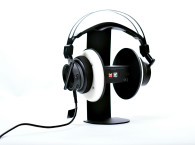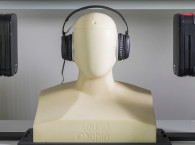
The human ear has various chambers and represents a complex acoustic load. In nonhuman testing an acoustic coupler is used for simulating the acoustic load of a human ear canal to more accurately attain realistic test data. Over the years there have been several attempts at developing a practical ear simulator coupler standard, eventually leading to the International Electrotechnical Commission (IEC) 60318 standard.
Today, the IEC 60318 standard is most commonly used for measuring “high-frequency” audiometric headphone responses and for low cost telephone handsets and general consumer circum/supra-aural headsets. The IEC 60711 standard is used for insert-type ear phones. This coupler (711) became an IEC standard in 1981 and is standardized up to 10 kHz. The 318 is standardized to 8 kHz.
These solutions are available from G.R.A.S. Sound & Vibration A/S, Brüel & Kjær Sound & Vibration Measurement A/S, Larson Davis, CRY and other acoustic test instrument vendors. The 711 was mostly conceived for telephone transmission quality, and calibration is limited to 10 kHz, which is not adequate for the wideband standards coming for the next generation of smartphones, let alone audiophile grade earphones and headphones.
Today, when measuring premium headphones with extended top-end response (e.g., the Sennheiser HD800 claims response to 44 kHz) and when benchmarking against these flagship headphones, the response above 10 kHz is often measured with the headphone driver removed and mounted on a baffle with a precision wideband microphone in the near field. When testing, all you can do is keep the test setup the same and check the relative extended range response between products. But, what is linear to the ear’s perception is anyone’s guess—not exactly precision data!
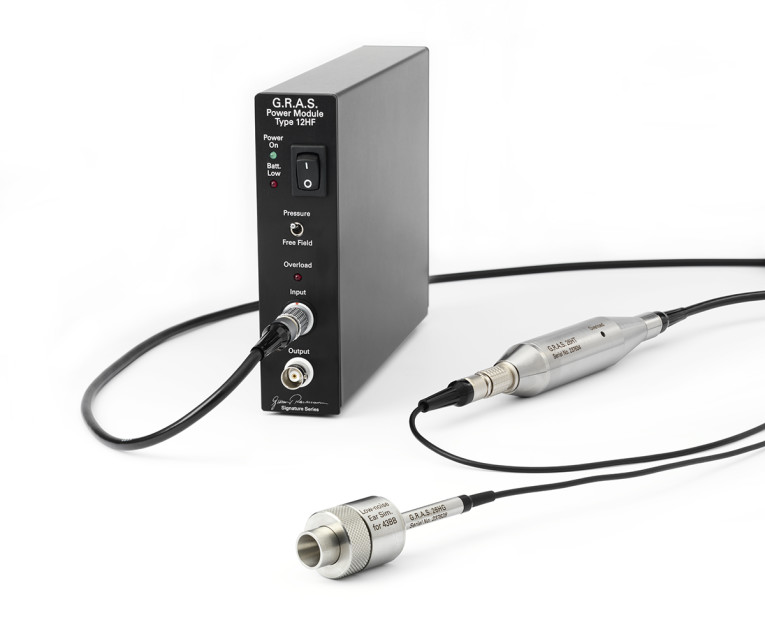
G.R.A.S. RA0045
The G.R.A.S. Type RA0045 ear simulator is an example of a 711 standard coupler for making acoustic measurements on earphones coupled to the human ear by ear inserts (e.g., tubes, ear molds, or ear tips). It is delivered with a built-in G.R.A.S. 0.5” pressure microphone Type 40AG and an individual calibration chart for the coupler microphone combination (see Photo 1). The 711 coupler is the heart of the G.R.A.S. Artificial Ear Types (the 43AC, the 43AG, etc.) and is found in the KEMAR head commonly used for headphone testing.
The problem with the 711 standard is this design results in a high Q peak centered about 13.5 kHz, ±1 kHz and the existing 711 coupler’s noise floor (mic plus preamp noise) are not as quiet as you might like for active noise control (ANC) work or testing super low distortion products. After 35 years of the 711 standard, we now have a significant refinement with the new G.R.A.S. 43BB (see Photo 2). The G.R.A.S. 43BB enables realistic testing out to 20 kHz and has noise floor so low that ANC residual noise and ultra-low distortion testing are now practical.
Noise Floor
Having the noise floor be below the threshold of human hearing is obviously desirable for designing and testing world class headphones. It is also desirable for those who want to design consumer headphones with active circuitry (i.e., ANC, DSP, Bluetooth, and wireless) enabling validation of much of the electronics.
The 43BB consists of the standardized IEC 60318-4 ear simulator and the G.R.A.S. 40HT low-noise microphone system. The 43BB is based on the standard 711 ear simulator and the 40HT system. There’s a fair bit of engineering in that mix to blend the two together. The G.R.A.S. 43BB’s low noise floor—below 10.5 dBA—can measure sound levels below or close to the threshold of human hearing (see Figure 1).
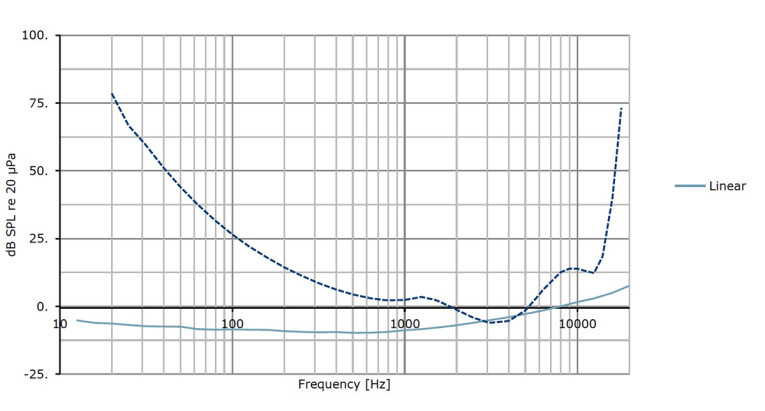
For comparison, a standard IEC 60318-4 (711) ear simulator with a G.R.A.S 40AG 0.5” microphone has a noise floor at 24.2 dB(A), not quite as good as some ANC headphones. Yet, you can still hear the microphone’s residual noise and the microphone preamp noise of these headphones in a quiet hotel room. So one of the motivations to develop the 43BB was to meet the audio industry’s need for R&D testing of in-ear headphones with ANC.
Because it can measure down to and below the threshold of human hearing, it can measure the influence of the electronics on the audio qualities of the earphones (see Figure 1). The other goal for the 43BB is that it can be used for measurements above 10 kHz, because its resonances above that frequency are well controlled, with low Q, and repeatable, making it much improved over the existing standardized artificial ear. Below 10 kHz, the frequency response is identical to that of a standard IEC 60318-4 ear simulator. Above 10 kHz, the differences in the microphone diaphragm impedance results in substantial differences.
The standard coupler has a high-Q resonance around 14 kHz related to the length of the ear canal and the diaphragm impedance. This sharp resonance does contribute to large measurement uncertainties. The IEC standard states, “Due to resonances in the acoustic transfer impedance of the occluded-ear simulator above 10 kHz, high measurement uncertainties, (e.g., in the order of 10 dB), can occur in earphone responses.”
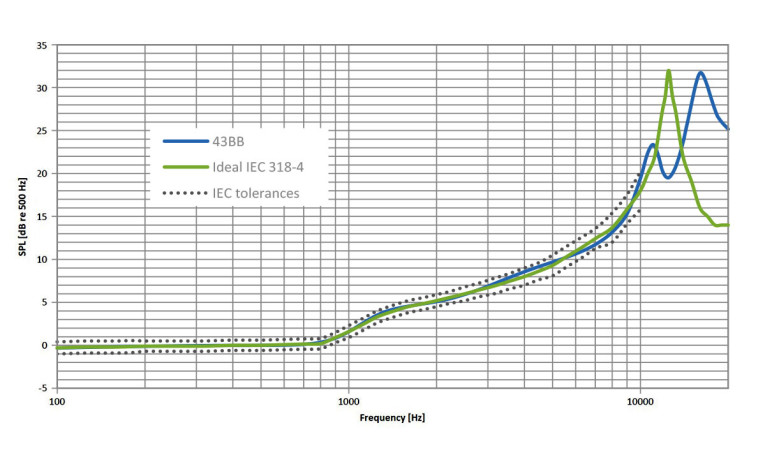
With the G.R.A.S.’s low noise microphone inside the ear simulator, the microphone’s high-frequency performance is tuned to coincide with the coupler’s naturally occurred Lambda/2 resonance (that is the 14 kHz peak). The result is a much smoother “double bump” as opposed to the violent high-Q resonance of the 711.
If you look at the IEC 60318 standard, it says to not trust your measurements above 10 kHz, and G.R.A.S. has conquered this limitation. Its low noise floor and usability above 10 kHz means that measurement results will have a strong correlation with the subjective feedback from test persons and users.

A Tool for Better Sound Quality
The system’s low inherent noise also means that the device under test’s (DUT) total harmonic distortion (THD), Rub & Buzz, and related perceptual distortions at very low levels can be investigated. This is intrinsically important in earphones and headphones. When a speaker system is listened to, much of the sound is reflected, and while this may provide some naturalness, the pristine clarity of the drivers is perhaps less critical.
The designer may get away with at least a bit less than perfection. The typical listening room’s ambient noise rarely reaches down to 25 dBA, but in the same room the typical closed-back headphone or earphone provides another 10 dB+ dBA passive attenuation to the ambient noise. So headphones and earphones provide very near field direct sound and lower ambient noise, enabling the driver characteristics to be perceived with more detail.
Headphone driver microspeakers often use a film diaphragm, mostly commonly polyethylene terephthalate (PET). More than 60% of the contributing sound is the “surround,” which flexes and makes break-up noises doing so. There are better materials, but measuring these quantitatively has been elusive.
The 43BB is a powerful tool in conjunction with a sophisticated acoustic analyzer for evaluating damped layer laminated diaphragms, sputtered coatings for diaphragms, treating lead-out wires that otherwise might be whipping, ferrofluid for voice coil anti-rocking, damping, and other refinements and separating wisdom from witchcraft in analyzing remedial measures. The 43BB’s low noise floor and usability above 10 kHz means that measurement results will have a strong correlation with the subjective feedback from test persons and users.

New Outer Ear for Improved Fit, Placement, and Seal
Testing ANC headphones and earphones typically focuses on low-end signal-to-noise ratios (SNRs). The big issue is both consistency and accuracy of the DUT’s fit to the coupler with realistic and repeatable results. Fit, placement, and seal (isolation) are significant aspects. Precision low-frequency response and super isolation are the benefit of the new pinna, concha, and canal of this new artificial ear simulator.
The main challenges with the standardized pinnae are the cylindrical metal ear canals and the rigidity of the pinnae in the Z-plane (toward the head). For products going into the concha and ear canal, the new G.R.A.S. KB5000 pinnae with the anthropometric ear canal offers a much more natural and realistic fit (see Photo 2). It greatly improves repeatability and enables engineers to test final version DUTs (with the ear tips fitted) more accurately in a much shorter amount of time. And because you have greater fit and more realistic seal, you are able to better characterize ANC (if applicable) and low-frequency performance as well as low-end passive isolation.
For circumaural products, the pinnae’s angle of protrusion is an accurate and troublesome feature. Because the pinnae were originally designed to hold a behind-the-ear (BTE) hearing aid, there was not much thought as to how they would collapse against the head under a force from a telephone handset or headphones. As a result, slimmer designed headphones are sometimes lifted off the side of the head and not correctly sealed. No proper seal, means there will not be a good indication of ANC or bass performance. This is remedied by removing material behind the pinnae, so the actual shape stays the same (as does the HRTF), but the pinnae are now allowed to compress against the head, just as with a real ear (see Photo 3).
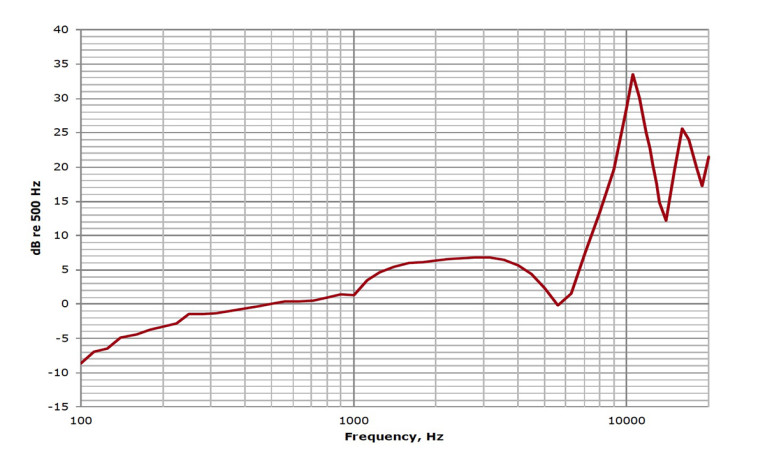
Physical Implementation and Upgrading Acoustic Test Jigs
The 43BB can be mounted in a monaural setup inside a KEMAR head (e.g., the 45BB and the 45BC) or a G.R.A.S. 45CA Hearing-Protector Test Fixture. Because of the length of the 26HG 0.25” preamplifier, it is not possible to use the 43BB in a binaural setup inside a G.R.A.S. test fixture. Although the company recommends the new anthropometric pinna with integrated ear canal (KB5000), there is no need to toss your existing test fixtures. You can mount the 43BB in a KEMAR (single channel) if you use a standard ear canal extension (e.g., the G.R.A.S RA0237 Straight Ear Canal Extension Kit for KEMAR). If mounted in the G.R.A.S. 45CA, a G.R.A.S RA0172 Pinna Holder Kit can be used (see Figure 3).
The 43BB is based on the standard 711 ear simulator and the 40HT system so the 43BB can be fitted with a right angle adapter that will allow for 43AG implementation and binaural fit in a KEMAR. Binaural fit will however not be possible in the 45CA.
Overall Opinion
This refined next-generation ear simulator was a project designed to improve fit and placement of in-the-ear, on-the-ear, and over-the-ear products. The repeatability of low-frequency response has been achieved along with stability of high-frequency response and greater dynamic range in the low end. The ability to use this new coupler as a laboratory tool for quantitative evaluation of exploratory techniques to refine high-grade earphones and headphones is exciting as well as a product review tool delivering higher correlation with subjective feedback while maintaining the aspects that are
viable of the familiar 711 coupler.
More info about these solutions available here: www.gras.dk/next-generation-headphone-testing
This article was originally published in audioXpress, March 2016.
Read more about the new G.R.A.S. KB5000 right pinna and the KEMAR simulator on next page >>



